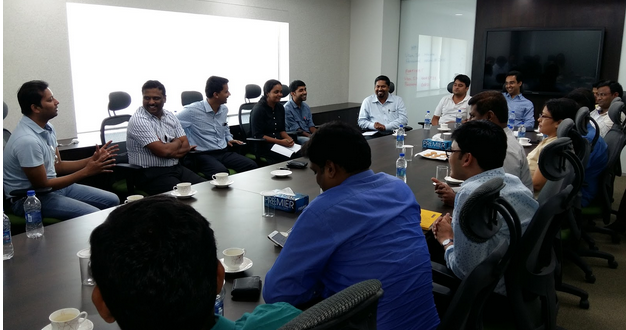The morning of the SaaSx2 event saw a great pre-event playbook at the Attune Tech’s Office.

Avlesh from WebEngage, Arvind from Attune Tech. and Suresh from KiSSFLOW came together to host the session and anchor the round table.
With a casual round of introductions, Suresh kickstarted the entire roundtable discussion with a question:
Who is your ideal user?
Identifying the ideal user for your product is the key to your entire product. Is it a product for developers? Is it for CEOs? Is it for mobile users? Is it for users of spreadsheets?
Once you identify your user, identify the ‘buying title’ and the ‘influencing title’. The ‘buying title’ would be the shot-caller whereas the ‘influencing title’ would play a major role in influencing the shot-caller to buy your product.
Sometimes, if your on-boarding process is straightforward, you can sidestep your segment. Figure out what’s happening, is your product gaining traction, etc., And then iterate your product.
Aligning Metrics – The key
This is when Avlesh (Webengage) (he was lost in the land of Chennai, damn the cabbie) joined the discussion. He stated a very crucial point, that sometimes entrepreneurs forget during their journey of building their product.
“Try aligning your product to your users’ metrics” was a great insight from him.
If you’re launching a second product, run it by your current customers.
Try answering these questions:
What’s that one thing that your user can relate to? What does he/she get out of this? What are you improving for them?
These are very practical and a data-driven points to consider before taking that step forward towards your market fit.
Instant Gratification -Connecting the dots
Arvind, connected these points to the psychological concept of ‘Instant Gratification’. What pain point are you trying to address? What’s that ‘wow’ moment they get when they start using your product? Something as simple as what they do everyday and how you can help them do it differently. If users get an immediate result from your product, they would be hooked to it.
Stickiness. The sole determiner.
Suresh mentioned a very simple but powerful point to elucidate product market fit.
“People who like your product will help you in scaling your product. But people who love your product will be your early adopters. Will be your referrers. Will be your evangelists. And they will help you achieve your product’s market fit!”
He also spoke about how product fit is not necessarily a price fit but much more than that. If users love your product, they really wouldn’t mind shelling out some extra money to buy it.
If you had noticed, all these points have something to do with user engagement.
Users see. Users love. Users buy. Users stick on.
Product Market Fit: The process
Product Market Fit isn’t a destination you aim to reach, but it’s a continuous journey.
Here are a few pointers to follow before you set out to find your fit.
- Understand your market.
- Estimate the market size.
- Don’t go after a broad range of things. You can’t be everything for everybody.
- Identify your segment. Your niche. That sweet-spot!
- Then, iterate your product. Strip/add features to suit the market.
Mohit from Jombay, who had some thoughtful points to add on to the entire discussion, mentioned about how it’s important to know what to focus on! Positioning your product is a prerequisite in obtaining a market fit.
Are we there yet?
When do you know your product has obtained a market fit? To understand the answer, ask this question. Are more strangers paying for your product? (not just your mom’s friends or cousin’s colleagues). Are you solving your users’ problem?
Sean Ellis answers this beautifully, in his blog.
“I’ve tried to make the concept less abstract by offering a specific metric for determining product/market fit. I ask existing users of a product how they would feel if they could no longer use the product. In my experience, achieving product/market fit requires at least 40% of users saying they would be “very disappointed” without your product. Admittedly this threshold is a bit arbitrary, but I defined it after comparing results across nearly 100 startups. Those that struggle for traction are always under 40%, while most that gain strong traction exceed 40%.”
Takeaways
Some quick points to sum up my takeaways from the session:
- Product market Fit isn’t a destination, it’s a journey.
- Understand your market.
- Know your customers.
- It’s not about the product. It’s about how you position it.
- Keep your product sticky.
- Align your products to your users’ metrics.
Avlesh’s sense of humor, Arvind’s sarcasm and Suresh’s guffaws helped maintain a lively atmosphere for the discussion 🙂 It was a great session overall with some brilliant takeaways from all of them.
Guest Post contributed by Anusha Murthy, ChargeBee

